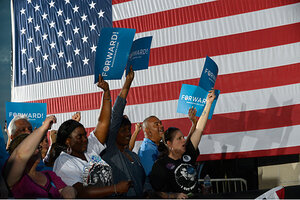Obama won, so why is his campaign still chugging along?
Obama for America sent its supporters a questionnaire Monday, asking which issues they'd like to organize around. But OFA's impact the first term was marginal at best. The reason it's still going is something else entirely.

A crowd of supporters cheers while first lady Michelle Obama speaks during a campaign stop for President Obama on election eve in Orlando, Fla., Nov. 5.
Phelan M. Ebenhack/AP
Washington
What do you do with the most vaunted voter turnout operation in American political history – Obama for America, or OFA – after its candidate has been safely reelected, and won’t ever run for office again?
Apparently you try to keep it alive, and turn it into an advocacy organization. Or a party-building operation. That’s what OFA is clearly doing with a 31-question survey that campaign manager Jim Messina sent out early Monday morning to President Obama’s millions of supporters – and to the reporters who follow the campaign.
Page 3 contains the first key question: “What issues would you be interested in volunteering or organizing around in the future? Select all that apply.”
There are 24 choices, starting with “accountability and openness in government” and ending at “veterans,” and with many others in between, from “avoiding the fiscal cliff” and “climate change/environment” to “jobs and trade” and “tax fairness.”
Then there’s a broader and probably more important question: “What would you choose as the top priority for this organizations [sic] in the weeks and years to come?”
The choices: 1. Passing the president’s legislative agenda. 2. Supporting candidates in upcoming elections. 3. Training a new generation of leaders and organizers. 4. Working on local issues that affect our communities.
Amid all the adulatory post-mortems on Mr. Obama’s turnout operation – the object of much Romney campaign envy – the underlying question about OFA may be this: Can a lame-duck president keep his organization going long enough to hand it over to his party’s next nominee, who may not be known until the spring of 2016? That’s a pretty tall order.
In January 2009, right before Inauguration Day, Obama for America turned into Organizing for America, part of the Democratic National Committee. In a video to supporters, Obama put out the call for continued involvement in his “movement.”
“The change we’ve worked so hard for will not happen unless ordinary Americans get involved, and supporters like you must lead the way,” Obama said, promising future communications on how to stay active. The one-time community organizer from Chicago had become Community Organizer in Chief.
The idea was to set up 50 state chapters of OFA to help further Obama’s legislative agenda. Right after taking office, amid an economic crisis, OFA held house parties to rally support for the president’s stimulus package. OFA also organized around Obama’s climate bill and the mother of all Obama initiatives, health-care reform, including more house parties, phone banks, calls to counter conservative tea partyers at town halls, and a contest for the best video promoting reform.
All those measures passed eventually (though the climate bill, known as “cap and trade,” died in the Senate), but assessments of OFA found its impact hard to quantify.
“It isn't that OFA hasn't done anything – it's that it's hard to say whether what it's done has actually mattered,” wrote Charles Homans in the liberal-leaning Washington Monthly in January 2010, a year into Obama's first term.
John Sides, a political scientist at George Washington University, puts it another way, speaking of health-care reform: “Maybe a few people needed some pressure at the margins, but even there, it’s hard to know what was the effect of pressure from OFA versus pressure from [then-House Speaker] Nancy Pelosi.”
Perhaps OFA’s most important role was simply to keep itself alive until Obama was ready to formally begin his reelection effort in April 2011 –when OFA once again became Obama for America.
Looking to the future, Mr. Sides suggests that it “won’t hurt” Obama to keep OFA active in helping with his second-term agenda and with the mid-term elections in 2014. But the real question, he says, is whether the guts of OFA can become part of the next Democratic presidential nominee’s campaign.
Much has been made of Obama’s ability to activate a broad and diverse electorate, but given his status as the first African-American major-party nominee, and then president, it’s not clear how transferrable his personal brand will be, Democratic strategists say.
And so the specific machinery of OFA may be beside the point. Sides points to groups like the Analyst Institute, which helps liberal interest groups with persuasion and mobilization through data-driven analysis.
“That’s where a lot of the [Democrats’] intellectual capital is housed more permanently,” Sides says. “They do that work all the time, because the interest groups they work with off-cycle, like labor unions, they’re never standing down, they’re always ready for the next battle.”
For now, though, the 2012 Obama campaign also isn’t standing down. In fact, it’s still fundraising. At the bottom of Monday’s e-mail from Mr. Messina there’s a familiar red button in the middle of the screen. It says, “Donate.”

